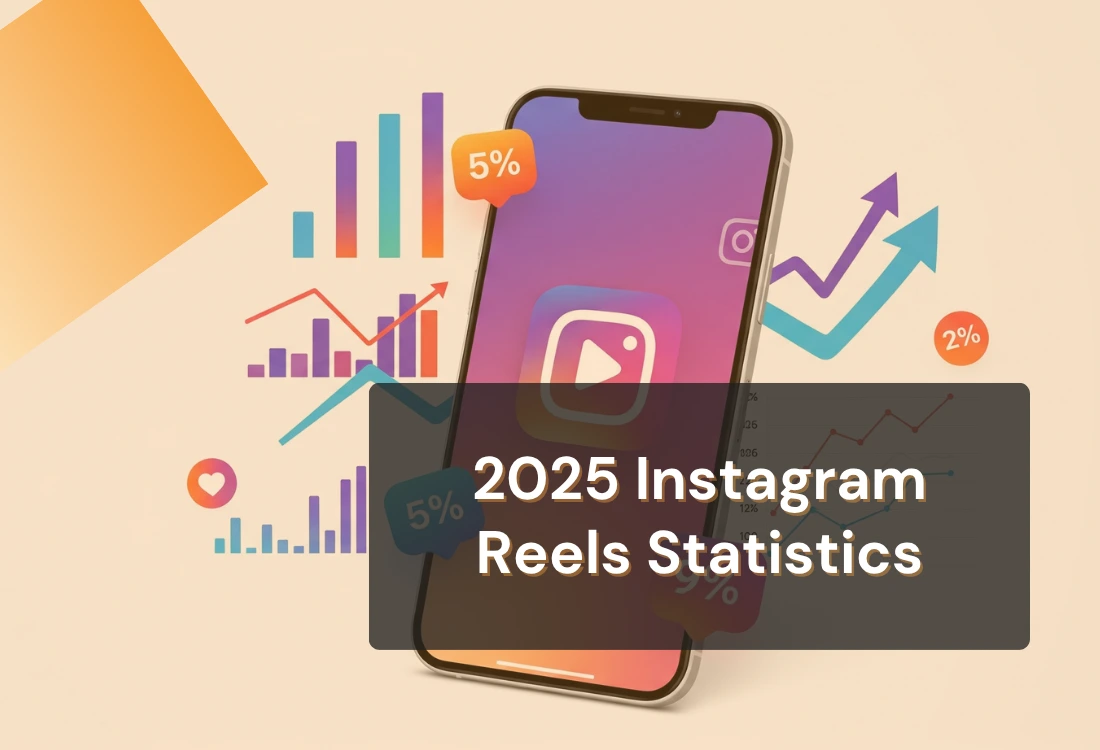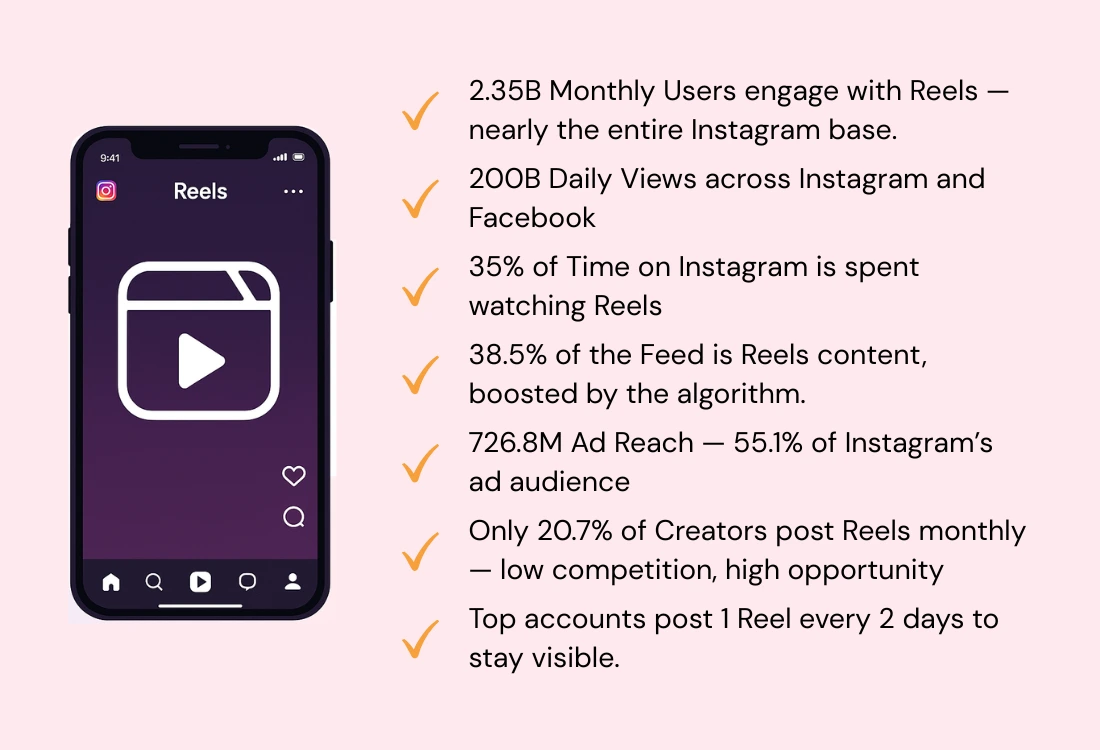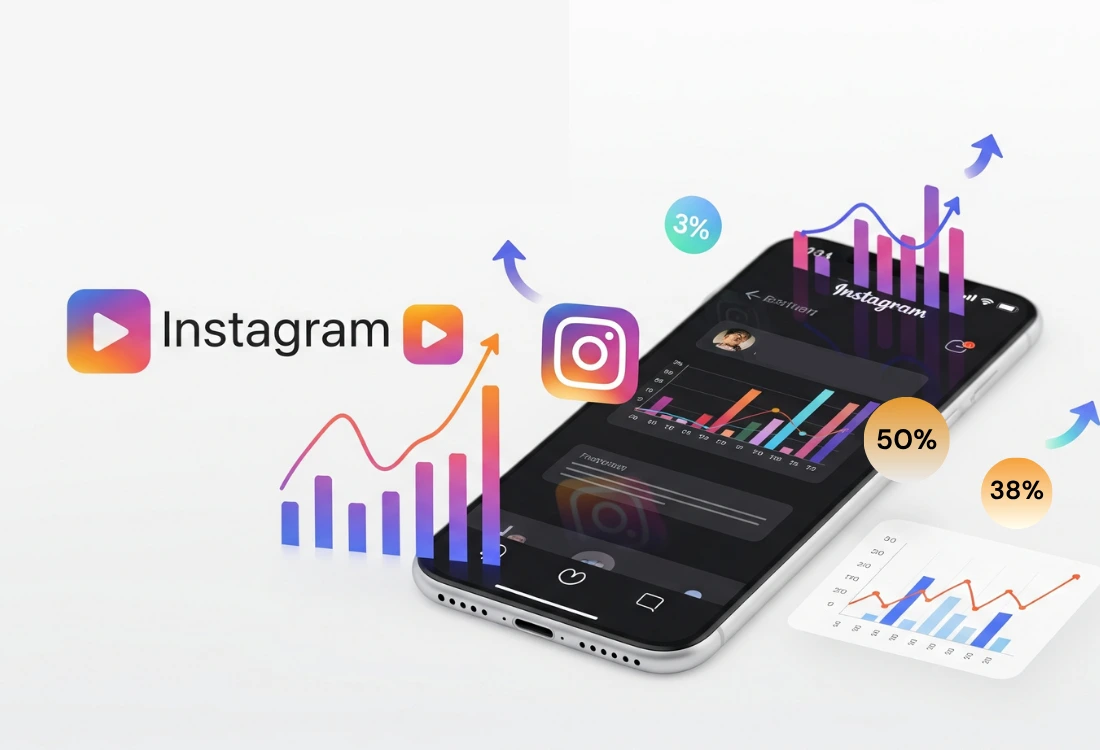



Instagram Reels have rapidly become the centerpiece of Instagram’s strategy, rivaling platforms like TikTok and YouTube Shorts in the short-form video arena. Launched in 2020 as 15-second clips, Reels have since expanded and now drive a huge portion of Instagram’s usage and growth.
In this article, we’ll break down the latest Instagram Reels statistics – including how many people use Reels, how Reels perform versus other content types, and key user behavior trends. We’ll also discuss how you can leverage these insights and even improve your Reels content creation (with tools like Teleprompter.com) to stay ahead of the curve.
In the sections below, we dive deeper into these statistics and what they mean for users, content creators, and marketers on Instagram.

Instagram Reels’ ad reach is huge – an estimated 726.8 million people (55.1% of Instagram’s ad audience) can be reached with Reels ads.
Instagram’s emphasis on Reels has given it incredible global reach. As of 2025, over 2 billion monthly active users engage with Instagram Reels content in some form. That’s effectively almost the entire Instagram user base (Instagram’s overall MAUs are ~2.3 billion). Some analyses even report about 2.35 billion monthly Reels users when accounting for cross-posting and multi-platform reach. In short, virtually everyone on Instagram is now watching or interacting with Reels regularly – a huge shift from a few years ago.
Engagement with Reels isn’t just broad, it’s deep. Collectively, users watch Reels clips tens of billions of times per day. Meta’s internal data showed Reels were getting 140 billion+ plays every day across Instagram and Facebook by late 2022, and that number has only grown – recent estimates suggest 200 billion daily Reel views in 2025. This explosive consumption highlights how addictive the short-video format is, keeping users scrolling through clip after clip.
All that Reel-watching adds up to a significant share of user attention on the app. In 2025, about 35% of total Instagram usage time is spent on Reels – over one-third of the app! For context, Reels (Instagram’s TikTok-style feed) has made Instagram one of the top destinations for short videos. In the U.S., Instagram now ranks as the third most-used app for short-form video, behind only TikTok and YouTube Shorts. This is impressive given TikTok’s head start; Instagram leveraged its massive user base to push Reels content to the forefront.
Instagram’s algorithm actively favors Reels to keep users engaged. As a result, nearly 38.5% of an average user’s Instagram feed is now filled with Reels content. Instagram even allows Reels to be shown to people who don’t follow you (via the Explore page and algorithmic suggestions), extending their reach further. In fact, Instagram prioritizes Reels in the algorithm to boost engagement and compete with TikTok. This means Reels have a higher chance of being seen by users than a standard photo post might.
Reels aren’t just for entertainment; they’re a key channel for advertisers too. Reels ads can now potentially reach about 726.8 million users on Instagram. That figure represents roughly 55% of Instagram’s total advertising audience – a testament to how many people are viewing Reels (since ads reach is proportional to active users). In some emerging markets, Reels adoption is especially high – for instance, India is a huge driver of Instagram Reels usage after TikTok was banned there. Instagram overall saw 547 million app downloads in 2024, and much of this growth is attributed to the popularity of features like Reels drawing in new users.
Even though user appetite for Reels is enormous, a surprisingly small proportion of creators are consistently making Reels. Only 20.7% of Instagram content creators post a Reel at least once a month. In other words, nearly 4 out of 5 creators either stick to photos, Stories, etc., or post Reels very rarely. This gap between user behavior and creator behavior is an opportunity – less competition among Reels content compared to how many users want to watch them. Brands or influencers that lean into Reels can fill this supply gap and gain visibility, since Instagram is actively pushing Reels to users’ feeds. It’s no surprise that many large accounts have increased their Reel output: Instagram accounts with over 50,000 followers now post about one Reel every two days on average to keep up with demand.
Carousel posts can slightly outperform Reels in engagement, getting ~12% more interactions on average (and 2.14× more than single photo posts). Still, Reels excel in reach and have high engagement rates overall.
Higher Reach Than Other Formats: One of the biggest reasons to use Reels is the superior reach. Data analyses show that Instagram Reels get ~1.36× more reach than carousel posts, and an impressive 2.25× more reach than traditional single-photo posts. In practical terms, if you post a Reel, it’s likely to be shown to significantly more people (especially non-followers) than an image post would. This is largely due to Instagram’s algorithm boost for Reels and the prominent placement they get in Explore and the Reels tab. As Instagram itself notes, short-form videos are now the fastest way to grow an audience on the platform.
Reels don’t just reach more people – they often engage them more too. The average engagement rate for Reels is about 1.23% (of an account’s audience per post), which tops the engagement rate for photo posts (~0.7%) and even carousel albums (~0.99%). That means on average, Reels generate more likes/comments/shares relative to audience size than other post types. Viewers are drawn in by the motion, audio, and storytelling of video, making them more likely to interact. In fact, one study found video posts (especially Reels) get 49% more engagement than static image posts on Instagram.
Interestingly, not every metric is dominated by Reels. Some analyses (e.g. a 3-year Buffer study) found that carousel posts can drive about 12% more total interactions than Reels on average. Carousel albums (multiple photos swiped in a post) have historically been strong performers for likes and saves, possibly because they invite users to swipe and spend more time on the post. The same study noted carousels get 2.14× more engagement than single-image posts, whereas Reels got about 1.9× more than single images (hence carousels slightly edged Reels in that sample). What this tells us is that content quality and context matter. Reels have the highest reach and generally high engagement, but a well-crafted carousel can still spark lots of interaction. Overall, Reels remain a top content type for engagement, even if they’re not absolutely guaranteed to beat every other format in every scenario.
Instagram’s algorithm changes have explicitly favored Reels in recent years. The platform now prioritizes Reels content, meaning the system will show Reels to users (even those who don’t follow the creator) more frequently than it would for photos. This preferential treatment is a key reason Reels get so much reach. Instagram is effectively rewarding creators who post Reels with more exposure. Additionally, new features (like the ability to cross-post Reels to Facebook easily) have expanded reach beyond Instagram itself. For creators and brands, the message is clear: if you want to maximize visibility and growth, leaning into Reels is a smart strategy.
hort and sweet tends to win on Reels. Instagram recommends and promotes shorter Reels (under 90 seconds), as completion rates drop on very long clips. In fact, Reels between 60–90 seconds have been found to generate about 24% more shares on average than shorter clips. This suggests that while attention spans are short, audiences do appreciate a bit of substance – a one-minute Reel that tells a story or delivers value is highly shareable. Another engagement booster is using trending audio and captions, since many users watch videos on mute. Overall, keeping Reels concise, engaging early (within the first 3 seconds), and visually dynamic will improve performance.
Timing can also influence Reel engagement. Analysis of user activity shows that the best time to post Reels is between 10 PM – 7 AM on Saturdays (late weekend nights). This window correlates with when global engagement tends to peak for Reels content. One theory is that by Saturday night, users have more leisure time to scroll entertainment content. However, optimal times can vary by audience; creators should check their own analytics. Still, this data-driven insight is interesting – posting during off-hours or weekends might help your Reel face less competition and gather more views while users are relaxing.

Understanding how users interact with Reels can help you craft content that resonates. Here are some notable user behavior trends and preferences on Instagram Reels:
How are content creators and brands responding to the user engagement with Reels? Here are some statistics and trends on how creators/brands are using Reels:
Instagram Reels have firmly established themselves as a core feature of the platform, driving both user engagement and content discovery. With over 2 billion monthly users interacting with Reels and daily views surpassing 140 billion, the short-form video format shows no signs of slowing down. Reels consistently outperform traditional post types in reach and engagement, making them a powerful tool for creators looking to grow their audience.
Despite this growth, many creators still haven’t tapped into the full potential of Reels. The current gap between user demand and content supply offers a valuable opportunity for those willing to adapt. By understanding key performance trends—such as ideal posting times, video length, and audience behavior—creators can produce content that resonates and performs well in Instagram’s algorithm.
As Reels continue to evolve, staying informed and responsive to what works will be the key to standing out and sustaining engagement in an increasingly video-driven landscape.
Resources
Cropink: Instagram Reels Statistics [2025] Growth & Engagement Update
Demandsage: How Many Instagram Reels Are there (2025 Statistics)
Adam Connell: 32 Top Instagram Reels Statistics For 2025
Accio: Instagram Business Trends
Buffer: Data Shows Instagram Reels are Best For Reach — But Not Engagement
Vidico: 25+ Instagram Reels Statistics, Data, & Trends (2025)
Social Pilot: 60+ Instagram Statistics Marketers Must Know in 2025



